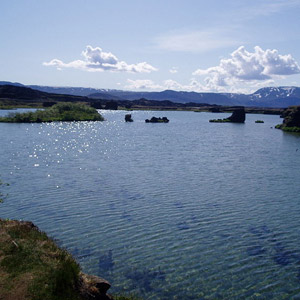Magazine | Voyages
Séjour ornithologique en Islande, du lac Myvatn à la réserve naturelle de Floï

Le lac Myvatn (Islande).
Source : Yelkrokoyade / Wikimedia Commons
Introduction
L’Islande est surtout connue pour son activité volcanique et ses glaciers (dont le plus vaste d’Europe), et elle est ainsi appelée la « Terre de glace et de feu ». Mais elle est aussi renommée d’un point de vue ornithologique, avec notamment la nidification de trois espèces principalement nord-américaines, le Plongeon imbrin, l’Arlequin plongeur et le Garrot d’Islande, et d’une espèce arctique, le Guillemot de Brünnich. Mais l’Islande est aussi connue pour ses immenses colonies d’oiseaux marins et pour la nidification de nombreux limicoles, canards et oies, ainsi que celle d’un rapace prestigieux, le Faucon gerfaut. Les espèces accidentelles en provenance d’Amérique du Nord constituent une autre attraction.
La période idéale pour découvrir les oiseaux islandais est comprise entre le 15 juin au 15 juillet: Alain Jouffray a visité le nord (notamment la fameux lac Myvatn) et l’ouest de l’île du 14 juin 2007 au 24 juin 2007, et nous publions ici son rapport.
Cet article vous est proposé en partenariat avec la liste OiseauxEthologie gérée par André Boussard.
Abstract
Iceland has long been famous for its volcanic activity and glaciers (having the biggest glacier in Europe); which is why it is called the land of ice and fire. To European birders it is also very famous for its three breeding bird species of American origin; Great Northern Diver, Harlequin Duck and Barrows Goldeneye and for one Arctic bird; Brünnichs Guillemot. Iceland is also famous for the occurrence of vagrants, but its situation in the North Atlantic makes it an excellent place to look for rarities coming from both North America and Europe.Birdwatching is easy from spring to autumn, as most roads are clear of snow. The ideal period for a foreign birdwatcher to visit the country is between the15th of June and the 15th of July. During this time all breeding birds have reached the island and are very obvious as they are defending territories. Furthermore, all ducks are still in breeding plumage and are easy to see.
Alain Jouffray visited the north and west part of the island from the 14th of June to the 24th of June 2007, and we propose here his report.
This article is presented in partnership with OiseauxEthologie, a list owned by André Boussard.
Poursuivez la lecture de cet article, en vous abonnant dès maintenant !
Découvrez les Archives d’Ornithomedia.com
Pour seulement 10,00 €TTC/an (ou 6,00 € les 6 mois)
Profitez de plusieurs centaines d’articles en accès illimité et sans aucun engagement.
Compléments
Auteur
Alain Jouffray
À lire sur le web
- Le site personnel d’André Boussard (Voyages-Ethologie): http://OiseauxEthologie.fr
- Le forum « OiseauxEthologie »consacré au comportement des oiseaux et aux endroits où l’on peut les observer: http://fr.groups.yahoo.com/group/OiseauxEthologie/
Ouvrages recommandés
- Islande de Philippe Gloaguen (Auteur), Olivier Page (Auteur), Véronique de Chardon (Auteur), Isabelle Al Subaihi (Auteur), Collectif (Auteur)
- Carte routière : Islande – Iceland de Cartes Freytag
Sources
- Les oiseaux d’Islande de Michel Breuil – Editions R. Chabaud – 1989
- www.lpo.fr/voyages/islande.shtml
- www.lmi.is/english/
- The Icelandic Birding Pages: www.hi.is/%7Eyannk/specialities.htm
- Site présentant les noms des oiseaux en 5 langues: www.iceland-nh.net/birds/index.html





Aucun commentaire sur ce sujet
Participer à la discussion !